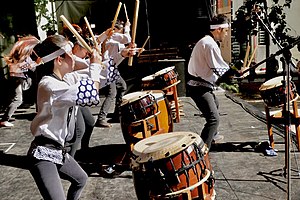 Japanese descendants in São Paulo. | |
| Total population | |
| 46.9 thousand (2023) Japanese citizens living in Brazil[1] and an estimated 2 million (2022) Brazilian nationals of Japanese descent living in Brazil (about 1% of the Brazilian population).[2] | |
| Regions with significant populations | |
| Japan: 211,840 (2023) Brazilian citizens living in Japan[3] (most of whom are of Japanese descent). 0.2% of Japan's population | |
| Languages | |
| Portuguese • Japanese | |
| Religion | |
| Predominantly: Roman Catholicism[4] Minority: Buddhism and Shintoism[5] Japanese new religions Protestantism | |
| Related ethnic groups | |
| Japanese, other nikkei groups (mainly those from Latin America and Japanese Americans), Latin Americans in Japan, Asian Latin Americans |
Japanese Brazilians (Japanese: 日系ブラジル人, Hepburn: Nikkei Burajiru-jin, Portuguese: Nipo-brasileiros, [ˌnipobɾaziˈlejɾus]) are Brazilian citizens who are nationals or naturals of Japanese ancestry or Japanese immigrants living in Brazil or Japanese people of Brazilian ancestry.[6] Japanese immigration to Brazil peaked between 1908 and 1960, with the highest concentration between 1926 and 1935. In 2022, Japan’s Ministry of Foreign Affairs stated that there were 2 million Japanese descendants in Brazil,[2] making it the country with the largest population of Japanese origin outside Japan. However, in terms of Japanese citizens, Brazil ranked seventh in 2023, with 46.9 thousand Japanese citizens.[a] Most of the Japanese-descendant population in Brazil has been living in the country for three or more generations and most only hold Brazilian citizenship. Nikkei is the term used to refer to Japanese people and their descendants.
Japanese immigration to Brazil officially began on June 18, 1908, when the ship Kasato Maru docked at Porto de Santos, bringing 781 Japanese workers to the coffee plantations in the São Paulo state countryside. For this reason, June 18 was established as the national day of Japanese immigration.[7][8] Immigration to Brazil ceased by 1973, with the arrival of the last immigrant ship, the Nippon Maru.[9] Between 1908 and 1963, 242,171 Japanese immigrants arrived in Brazil, making them the fifth-largest immigrant group after Portuguese, Italian, Spanish, and German immigrants.[b] Currently, most Japanese Brazilians live in the states of São Paulo and Paraná.[11]
In the early 20th century, Japan was overpopulated, and its predominantly rural population experienced significant poverty. At the same time, the Brazilian government was encouraging immigration, especially to supply labor for coffee plantations in São Paulo. Coffee was Brazil's main export product, and the country’s financial health relied on it. Much of the labor on Brazilian coffee plantations came from Italian immigrants, whose passage by ship was subsidized by the Brazilian government. However, in 1902, the Italian government issued the Prinetti Decree, which banned subsidized immigration to Brazil due to reports that Italian immigrants were being exploited as laborers on Brazilian farms.[12] Consequently, the São Paulo government sought new sources of labor from other countries, including Japan, and Japanese immigration to Brazil developed in this context.
Labor contracts on coffee plantations required immigrants to work for five years, but conditions were so poor that many left within the first year. Through great effort, some Japanese workers managed to save enough to buy their own land, with the first Japanese land purchase occurring in 1911 in the São Paulo countryside. Over the decades, Japanese immigrants and their descendants gradually moved from rural areas to Brazilian cities. By the early 1960s, the Japanese Brazilian urban population had surpassed the rural one. Many Japanese immigrants began working in small businesses or providing basic services. In Japanese tradition, the eldest son would continue the family business to help support his younger siblings' education. By 1958, Japanese and their descendants, though less than 2% of the Brazilian population, accounted for 21% of Brazilians with education beyond high school. A 2016 IPEA study found that Japanese descendants had the highest average educational and salary levels in Brazil.[13] With Brazil’s economic deterioration from the late 1980s, many Japanese descendants from Brazil began migrating to Japan, in search of better economic conditions. These individuals are known as Dekasseguis.
- ^ a b Countries with the highest number of Japanese residents in 2023 (in 1,000s)
- ^ a b "Japan-Brazil Relations (Basic Data)". Retrieved October 8, 2022.
- ^ 令和5年末現在における在留外国人数について
- ^ Adital – Brasileiros no Japão Archived July 13, 2006, at the Wayback Machine
- ^ "Brazil". state.gov. September 14, 2007. Retrieved May 4, 2018.
- ^ Gonzalez, David (September 25, 2013). "Japanese-Brazilians: Straddling Two Cultures". Lens Blog. The New York Times. Archived from the original on October 2, 2013. Retrieved September 27, 2013.
- ^ Dia Nacional da Imigração Japonesa, Prefeitura Municipal de Promissão
- ^ 18 de junho, Dia Nacional da Imigração Japonesa, Migalhas
- ^ "Site Oficial da ACCIJB - Centenário da Imigração Japonesa no Brasil - História da Imigração". centenario2008.org.br. Archived from the original on August 31, 2014.
- ^ "Entrada de estrangeiros no Brasil segundo as principais nacionalidades pelos 4 períodos constituídos". Archived from the original on October 3, 2008. Retrieved December 10, 2022.
- ^ Resistência & integração : 100 anos de imigração japonesa no Brasil. 2008. p. 64. ISBN 9788524040146. Retrieved October 28, 2020.
{{cite book}}:|website=ignored (help) - ^ Angelo Trento (1989). Do outro lado do Atlântico: um século de imigração italiana no Brasil. Livraria Nobel. p. 574. ISBN 852130563X.
- ^ Leonardo Monasterio (September 2016). "Sobrenomes e Ancestralidade No Brasil" (PDF). IPEA. Retrieved November 17, 2016.
Cite error: There are <ref group=lower-alpha> tags or {{efn}} templates on this page, but the references will not show without a {{reflist|group=lower-alpha}} template or {{notelist}} template (see the help page).